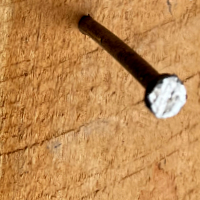 Stargardtiens have to constantly compensate for the reduced sense of sight. The next best channel of perception is hearing. And you can get quite far with it as I recently realised again while hammering in a nail.
Stargardtiens have to constantly compensate for the reduced sense of sight. The next best channel of perception is hearing. And you can get quite far with it as I recently realised again while hammering in a nail.
A nail is quite a small thing. Hitting it with a hammer is not easy. Of course, I could hold it with my other hand and trust the body sense (i.e. the right hand knows where the left hand is). But the risk of bruised fingers is too great. A nail gun would be a solution but is quite a large investment for a single nail.
So while I'm hammering along, I notice that the sound of the impact tells me a lot about the course of my action. If I hit the nail correctly, an almost harmonic ringing occurs immediately after the hitting sound. The deeper the nail penetrates the wood, the higher the tone. If the hammer doesn't hit properly, the ringing tone becomes dissonant. And if the blow goes completely wrong and the nail is bending, the sound falls into the same category as a rotten apple falling from a tree.
There are countless examples where I orient myself more or exclusively to the noises. For example when crossing the street here in Nyahururu. I can more or less see the cars coming, but the motorbike taxis are too small and too fast. But they make a lot of noise, so I can hear them well. When I'm by myself, I only cross the street when I can no longer hear the traffic. Which means that I sometimes stand there for 10 minutes and listen.
Or my kettle: As a fan of green tea, I bought an oven thermometer with the kettle, which I can use to measure when the water has reached 80 degrees Celsius, the recommended temperature for green tea. Over time I've learned to listen to my kettle. The heating of the water produces a whirring sound, the pitch of which increases continuously with the increased temperature. I now know what 80 degrees sounds like and no longer need the thermometer.
Here's a little exercise: Take a large water glass and try to fill it with your eyes closed without making it overflow. I'm sure you'll figure it out after a few tries. Then try filling it only halfway. This should be easy as you know the acoustic properties of the glass now.
This article is part of the series "Stargardt in Africa".
